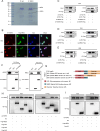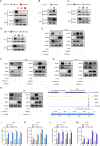MBD2 regulates the progression and chemoresistance of cholangiocarcinoma through interaction with WDR5
- PMID: 39350229
- PMCID: PMC11440836
- DOI: 10.1186/s13046-024-03188-4
MBD2 regulates the progression and chemoresistance of cholangiocarcinoma through interaction with WDR5
Abstract
Background: Cholangiocarcinoma (CCA) is a highly malignant, rapidly progressing tumor of the bile duct. Owing to its chemoresistance, it always has an extremely poor prognosis. Therefore, detailed elucidation of the mechanisms of chemoresistance and identification of therapeutic targets are still needed.
Methods: We analyzed the expression of MBD2 (Methyl-CpG-binding domain 2) in CCA and normal bile duct tissues using the public database and immunohistochemistry (IHC). The roles of MBD2 in CCA cell proliferation, migration, and chemoresistance ability were validated through CCK-8, plate cloning assay, wound healing assays and xenograft mouse model. In addition, we constructed a primary CCA mouse model to further confirm the effect of MBD2. RNA-seq and co-IP-MS were used to identify the mechanisms by how MBD2 leads to chemoresistance.
Results: MBD2 was upregulated in CCA. It promoted the proliferation, migration and chemoresistance of CCA cells. Mechanistically, MBD2 directly interacted with WDR5, bound to the promoter of ABCB1, promoted the trimethylation of H3K4 in this region through KMT2A, and activated the expression of ABCB1. Knocking down WDR5 or KMT2A blocked the transcriptional activation of ABCB1 by MBD2. The molecular inhibitor MM-102 targeted the interaction of WDR5 with KMT2A. MM-102 inhibited the expression of ABCB1 in CCA cells and decreased the chemoresistance of CCA to cisplatin.
Conclusion: MBD2 promotes the progression and chemoresistance of CCA through interactions with WDR5. MM-102 can effectively block this process and increase the sensitivity of CCA to cisplatin.
Keywords: ABCB1; Cholangiocarcinoma; H3K4me3; MBD2; WDR5.
© 2024. The Author(s).
Conflict of interest statement
The authors declare that they have no competing interests.
Figures








References
-
- Forner A, Vidili G, Rengo M, Bujanda L, Ponz-Sarvisé M, Lamarca A. Clinical presentation, diagnosis and staging of cholangiocarcinoma. Liver International: Official J Int Association Study Liver. 2019;39(Suppl 1):98–107. - PubMed
-
- Roth GS, Neuzillet C, Sarabi M, Edeline J, Malka D, Lièvre A. Cholangiocarcinoma: what are the options in all comers and how has the advent of molecular profiling opened the way to personalised medicine ? European journal of cancer (Oxford, England: 1990). 2023; 179: 1–14. - PubMed
-
- Khan SA, Thomas HC, Davidson BR, Taylor-Robinson SD, Cholangiocarcinoma. Lancet (London England). 2005;366:1303–14. - PubMed
MeSH terms
Substances
Grants and funding
LinkOut - more resources
Full Text Sources
Medical
Molecular Biology Databases
Miscellaneous

